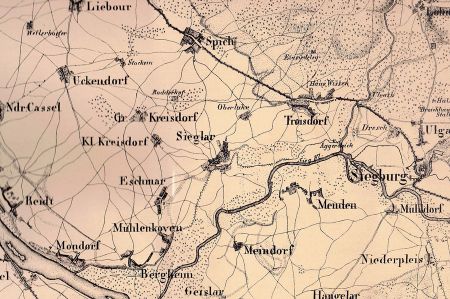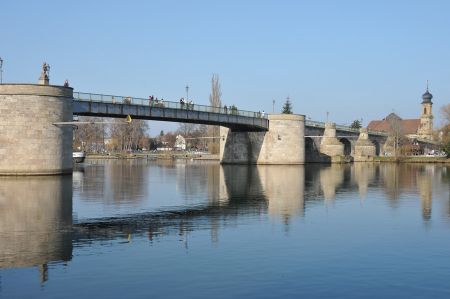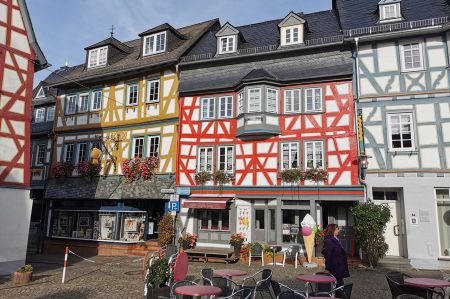After the carnivalists had slowly "withdrawn" from the Bad Camberg market square, peace and quiet was possible again to enjoy the excellently restored half-timbered buildings in the old town.
We were particularly taken with the half-timbered houses with their shops on the Bad Camberg market square. Our further research also brought us the realization that the medieval Via Publica ran right here along the market square.
Comparable to the Roman road network about a thousand years earlier, roads were gradually laid in the Taunus and Spessart valleys in the 12th century. This was mainly due to the increase in trade in goods, but also the growing danger on the Hohe Strasse. This is how the Emstalstrasse came about, for example, a section of the old Via Publica (Brussels-Prague).
Via Publica from Brussels in Flanders via Frankfurt, Würzburg to Prague in Bohemia
 The Via Publica was first mentioned in 839 in a diploma from Emperor Louis the Pious. This mention was in Altfeld im Spessart. In this exchange document, however, another road was mentioned, the Heristrata = military road. This mention was between Bischbrunn and Rohrbrunn in the Spessart, where the former federal highway 8 ran.
The Via Publica was first mentioned in 839 in a diploma from Emperor Louis the Pious. This mention was in Altfeld im Spessart. In this exchange document, however, another road was mentioned, the Heristrata = military road. This mention was between Bischbrunn and Rohrbrunn in the Spessart, where the former federal highway 8 ran.
The Via Publica is said to have once led from Brussels in Flanders via Frankfurt, Würzburg and Nuremberg to Prague in Bohemia. Whereby a documented mention of the Via Publica between Brussels, Cologne and Frankfurt is not known. However, there is an earlier mention of the Via Publica from the year 815 in the deserted village of Lochheim, in today's municipality of Biedesheim am Rhein, about 50 km south-east of Mainz. And another mention in Bad Salzschlürf near Fulda from the 9th century. As well as two mentions near Drensteinfurt, south of Münster from the year 1331 and 1440.
 In the Middle Ages, the trade route is also said to have connected the trading cities of Cologne, Frankfurt, Nuremberg and Regensburg. An assertion, but without proof. The Stone Bridge in Regensburg (1135-1146), the Inn Bridge in Passau (1143), the Lahn Bridge in Limburg (completed 1341) and the Main Bridges in Würzburg (1133), Frankfurt (before 1222) and Kitzingen (before 1300) are some of the oldest stone bridges in Central Europe and testify to their historical importance.
In the Middle Ages, the trade route is also said to have connected the trading cities of Cologne, Frankfurt, Nuremberg and Regensburg. An assertion, but without proof. The Stone Bridge in Regensburg (1135-1146), the Inn Bridge in Passau (1143), the Lahn Bridge in Limburg (completed 1341) and the Main Bridges in Würzburg (1133), Frankfurt (before 1222) and Kitzingen (before 1300) are some of the oldest stone bridges in Central Europe and testify to their historical importance.
In 1615, the hereditary postmaster Lamoral von Taxis was commissioned by Emperor Matthias to set up a postal route from Brussels via Frankfurt and Nuremberg to Prague. For this purpose, the Via Publica was expanded from Altfeld in the direction of Würzburg.
Today, federal highway 8 is largely identical to both old streets, the Heristrata and the Via publica.
The medieval trade routes usually did not lead through the swampy valleys, which were impassable after rain, but over the dry mountain roads.
But these roads also had to cross rivers, which are always deep in the valleys.
Part of the Via Publica is also known as the mouse path. However, the first mention of the mouse path is only in the Tranchot maps of 1801-1814.
In addition to the old Cologne country roads, the mouse path was part of the medieval network of paths on the right bank of the Rhine. The mouse path connected the Rheingau via Limburg an der Lahn, Altenkirchen, Siegburg, Köln-Dünnwald, Opladen, Langenfeld and Hilden with Duisburg, where it reached the Hellweg. South of Limburg the path is known under the name Hühnerweg, Hühnerstraße or Mainzer Straße, north of Hilden it is called Butenweg. The name Mauspfad was only used for the piece between Sieg and Hilden. In Cologne on the right bank of the Rhine, the mouse path runs directly along the former bank of the glacial stream of the Rhine and is named after the respective location.
The mouse path in its function and meaning
The mouse path should not be imagined as a road in the modern sense, rather it was a path that was kept clear by frequent use and partly by maintenance measures, such as cutting the undergrowth. Tolls were levied at customs houses for such care measures. Despite its small width, the path presumably played a major role in the early Iron Age development of the heath terrace on the right bank of the Rhine; it may even have been the main route through which southern culture penetrated north. At the time of the Hanseatic League, the mouse path formed the Rhenish part of the important traffic route between Cologne, Essen, Dortmund and Soest and further in the direction of Hamburg, Bremen and Lübeck. Some sections of this route were later followed by the also historical long-distance trade route from Genoa via the Little St. Bernhard, Basel, Mainz, Siegburg to the Netherlands. This road connection, the former Via Publica, later called Köln-Arnheimer Chaussee between Cologne and Arnheim, is roughly identical to today's B 8. One reason for the rise of the new trade route, combined with the simultaneous decline of the mouse path, was the Battle of Worringen and the subsequent rise of Düsseldorf to later become a residential city. As a result, trade shifted to the new connection via Düsseldorf.
But back to the Bad Camberg through road
In 1768 Electoral Trier began with the chaussee-like expansion of the country roads as well as the road from Limburg to the state border between Würges and Walsdorf, which was completed in 1780. The superstructure of the road, which led past the Camberger Untertorturm west of the then city limits, was completely destroyed again after two to three years due to heavy traffic. In 1786, the citizenry applied for the road to be taken from Erbach to the Obertorturm, then through the town to the Untertorturm and then on to Würges. However, the application was rejected. Due to the Trier electoral road construction order of 1753, the citizens of the Camberg office had to do roadside work in spring and autumn. The electoral court chamber provided the labour and material costs for the bridge construction, while the municipalities and the office had to provide the materials. All forced labor was only abolished after the 1848 revolution.
At the beginning of the 20th century, this road developed into trunk road 8, which later became Reichsstraße 8 and today's Bundesstraße 8. It currently runs through Erbach, Bad Camberg and Würges and passes Oberselters.
Please read as well:
Unexpected surprise in Bad Camberg in Hesse
Arnold Esch - Roman roads in their landscape
Yilan Kalesi at Ceyhan close to Adana


